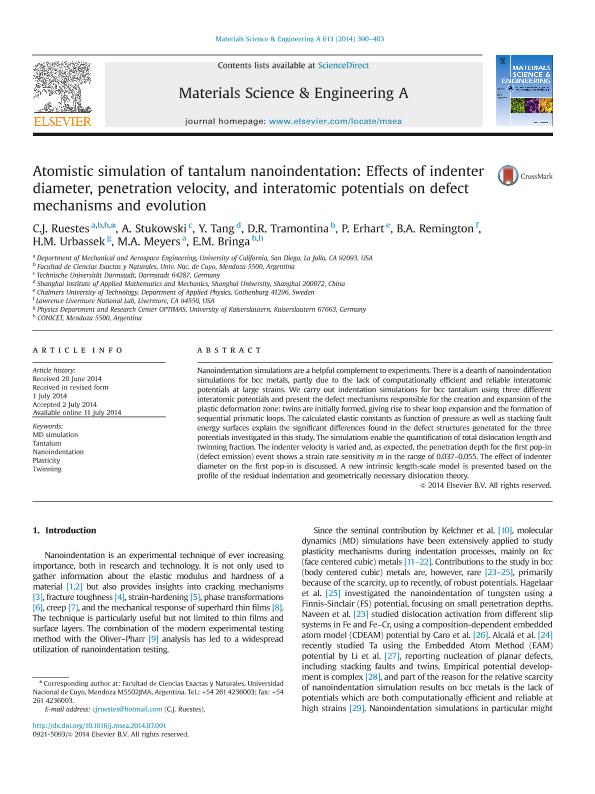Mostrar el registro sencillo del ítem
dc.contributor.author
Ruestes, Carlos Javier

dc.contributor.author
Stukowski, Alexander
dc.contributor.author
Tang, Yizhe

dc.contributor.author
Tramontina Videla, Diego Ramiro

dc.contributor.author
Erhart, Paul
dc.contributor.author
Urbassek, Herbery
dc.contributor.author
Remington, Bruce A.
dc.contributor.author
Meyers, Marc A.

dc.contributor.author
Bringa, Eduardo Marcial

dc.date.available
2017-12-07T16:10:52Z
dc.date.issued
2014-07
dc.identifier.citation
Ruestes, Carlos Javier; Stukowski, Alexander; Tang, Yizhe; Tramontina Videla, Diego Ramiro; Erhart, Paul; et al.; Atomistic simulation of tantalum nanoindentation: effects of indenter diameter, penetration velocity, and interatomic potentials on defect mechanisms and evolution; Elsevier Science Sa; Materials Science and Engineering A: Structural Materials: Properties, Microstructure and Processing; 613; 7-2014; 390-403
dc.identifier.issn
0921-5093
dc.identifier.uri
http://hdl.handle.net/11336/29962
dc.description.abstract
Nanoindentation simulations are a helpful complement to experiments. There is a dearth of nanoindentation simulations for bcc metals, partly due to the lack of computationally efficient and reliable interatomic potentials at large strains. We carry out indentation simulations for bcc tantalum using three different interatomic potentials and present the defect mechanisms responsible for the creation and expansion of the plastic deformation zone: twins are initially formed, giving rise to shear loop expansion and the formation of sequential prismatic loops. The calculated elastic constants as function of pressure as well as stacking fault energy surfaces explain the significant differences found in the defect structures generated for the three potentials investigated in this study. The simulations enable the quantification of total dislocation length and twinning fraction. The indenter velocity is varied and, as expected, the penetration depth for the first pop-in (defect emission) event shows a strain rate sensitivity m in the range of 0.037-0.055. The effect of indenter diameter on the first pop-in is discussed. A new intrinsic length-scale model is presented based on the profile of the residual indentation and geometrically-necessary dislocation theory.
dc.format
application/pdf
dc.language.iso
eng
dc.publisher
Elsevier Science Sa

dc.rights
info:eu-repo/semantics/openAccess
dc.rights.uri
https://creativecommons.org/licenses/by-nc-sa/2.5/ar/
dc.subject
Md Simulation
dc.subject
Tantalum
dc.subject
Nanoindentation
dc.subject
Plasticity
dc.subject
Twinning
dc.subject.classification
Física Atómica, Molecular y Química

dc.subject.classification
Ciencias Físicas

dc.subject.classification
CIENCIAS NATURALES Y EXACTAS

dc.title
Atomistic simulation of tantalum nanoindentation: effects of indenter diameter, penetration velocity, and interatomic potentials on defect mechanisms and evolution
dc.type
info:eu-repo/semantics/article
dc.type
info:ar-repo/semantics/artículo
dc.type
info:eu-repo/semantics/publishedVersion
dc.date.updated
2017-11-09T13:35:15Z
dc.journal.volume
613
dc.journal.pagination
390-403
dc.journal.pais
Países Bajos

dc.journal.ciudad
Amsterdam
dc.description.fil
Fil: Ruestes, Carlos Javier. Universidad Nacional de Cuyo. Facultad de Ciencias Exactas y Naturales; Argentina. Consejo Nacional de Investigaciones Científicas y Técnicas. Centro Científico Tecnológico Conicet - Mendoza; Argentina. University of California. Department of Mechanical and Aerospace Engineering; Estados Unidos
dc.description.fil
Fil: Stukowski, Alexander. Universitat Technische Darmstadt; Alemania
dc.description.fil
Fil: Tang, Yizhe. Shanghai University. Shanghai Institute Of Applied Mathematics And Mechanics; China
dc.description.fil
Fil: Tramontina Videla, Diego Ramiro. Universidad Nacional de Cuyo. Facultad de Ciencias Exactas y Naturales; Argentina
dc.description.fil
Fil: Erhart, Paul. Chalmers University of Technology, Department of Applied Physics; Suecia
dc.description.fil
Fil: Urbassek, Herbery. University of Kaiserslautern. Physics Department and Research Center OPTIMAS; Estados Unidos
dc.description.fil
Fil: Remington, Bruce A.. Lawrence Livermore National Laboratory;
dc.description.fil
Fil: Meyers, Marc A.. University of California. Department of Mechanical and Aerospace Engineering; Estados Unidos
dc.description.fil
Fil: Bringa, Eduardo Marcial. Universidad Nacional de Cuyo. Facultad de Ciencias Exactas y Naturales; Argentina. Consejo Nacional de Investigaciones Científicas y Técnicas. Centro Científico Tecnológico Conicet - Mendoza; Argentina
dc.journal.title
Materials Science and Engineering A: Structural Materials: Properties, Microstructure and Processing

dc.relation.alternativeid
info:eu-repo/semantics/altIdentifier/url/http://linkinghub.elsevier.com/retrieve/pii/S0921509314008466
dc.relation.alternativeid
info:eu-repo/semantics/altIdentifier/doi/http://dx.doi.org/10.1016/j.msea.2014.07.001
Archivos asociados
